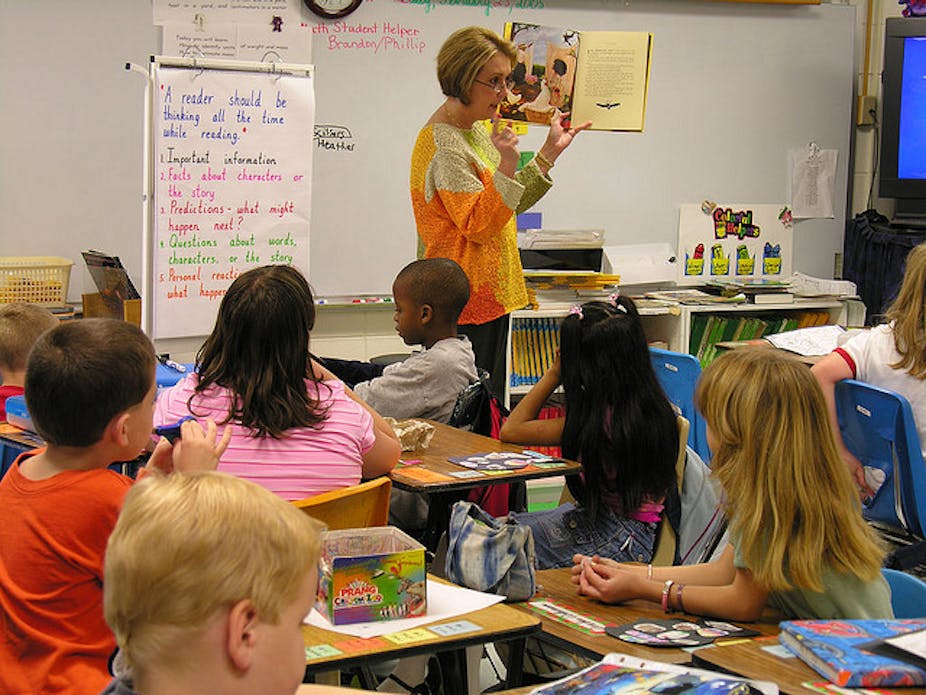Prominent Indigenous Australian Noel Pearson is promoting Direct Instruction in Cape York schools, prominent educationalists have dismissed it as “pedagogy for the poor”, and Education Minister Christopher Pyne has just found $22 million to extend it to other remote schools. But what is Direct Instruction and what has it got to do with good reading teaching?
The Direct Instruction method
Direct Instruction is a teaching method developed in the United States in the 1960s, focused particularly on the needs of children with learning difficulties. Building on behaviourist learning theory, Direct Instruction breaks each learning task down into its smallest component and requires mastery of simpler skills before proceeding to more difficult skills. Students are grouped according to their achievement, teachers are provided with closely scripted lesson plans, students respond to the teacher orally and as a group, and the group does not move on until everyone understands the material.
Direct Instruction is a family of approaches, rather than a single approach. What is being trialled in the Cape is a particularly pure form of Direct Instruction, based directly on the work of its originators Englemann and Becker. Other similar and successful approaches have been comprehensive school reform programs such as Success for All in the United States and effective remedial reading programs such as MultiLit in Australia.
Education researcher John Hattie’s comprehensive meta-analysis of curriculum reforms rates Direct Instruction among the most effective teaching strategies. Direct Instruction reading programs, however, are nested: Direct Instruction is the approach and reading is the content.
In addition to the Direct Instruction approach of ability grouping, scripting, mastery learning and stimulus response teaching, these programs often include characteristics associated with the “gold standard” for effective reading teaching: relentless attention to the component skills required for understanding the letter-sound relationships in written text, and reinforcement of these components in the context of book reading.
The gold standard
The teaching of reading is probably the most researched topic in education. The gold standard consensus, articulated by the US National Reading Panel and supported by the Australian Rowe Review, is that the key components of effective reading teaching are phonemic awareness, phonics, fluency, vocabulary and comprehension.
Phonemic awareness is the capacity to break words down into sound units (phonemes): H/A/T; SH/I/P. Some children learn this before they go to school from book reading with parents and from playing rhyming games. Those who don’t already know this need to practise segmenting words into sounds and identifying rhyming patterns in words.
Phonics is knowledge about matching these sounds to letters: how graphemes (letters and letter combinations) represent phonemes. This allows readers to decode new written words by sounding out the phonemes rather than memorising whole words.
Fluency is the capacity to read unfamiliar texts quickly, accurately and automatically. This is often developed by guided oral reading, repeated reading aloud with feedback and guidance from teachers, peers or parents.
Vocabulary development is essential to skilled reading. It can be taught directly, by introducing and defining new words, as well indirectly by teaching word-learning strategies such as word roots, dictionary use and context clues.
Comprehension is the goal of reading teaching. It involves making meaning by connecting what the reader already knows with what has been read, using strategies such as answering questions, generating questions and summarising.
Direct Instruction and the gold standard
Reading programs that deal effectively with all five of the essential components, teaching both skills for decoding (phonemic awareness and phonics) and for reading in context (fluency, vocabulary and comprehension), are likely to be effective in teaching young children to read. What makes Direct Instruction programs incorporating these components attractive is the relative lack of variability in teaching quality that they promise. Rather than requiring a teacher to have the knowledge and wisdom to produce their own individual gold standard program, teachers are trained to follow a published program.
This promise of reduced variability is particularly attractive in schools that have many inexperienced teachers and high levels of teacher transiency. Perhaps that is why Bruce Wilson’s review of Indigenous education in the Northern Territory has recommended that the use of structured skills-based literacy programs be mandated. Although he has stopped short of recommending universal Direct Instruction in bush schools, he has recommended either Direct Instruction or explicit programs such as Jolly Phonics (where students learn the sounds used in English rather than the letters of the alphabet) or Crack the Code to teach phonics and phonemic awareness.
What’s not to like?
Critics of Direct Instruction are concerned about what is lost on the way. Leading Indigenous educator Chris Sarra, chair of the Stronger Smarter Institute, has dismissed Direct Instruction as a remedial program that takes out the human connection between children and teachers and doesn’t allow teachers to be exceptional.
Alan Luke, a leading Australian literacy researcher, acknowledges the impact that Direct Instruction has on students’ basic skills test scores, but argues that it is not a complete solution. The scripted lessons leave no space for local cultural knowledge or community contexts and prevent teachers from responding to differences among students or in their learning contexts.
In the Cape, however, it is too soon to tell whether the shift to Direct Instruction will fulfil its promise of better test scores. In the recent evaluation by the Australian Council for Educational Research, school and community members reported that Direct Instruction was having a positive impact on student outcomes, but the researchers were not yet able to say whether or not the initiative has had an impact on student learning.

